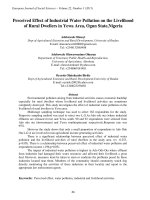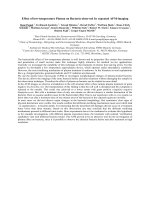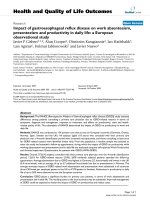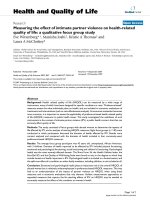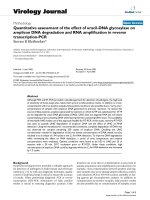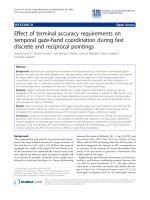study the effect of welding joint location on the fatigue strength and fatigue life for steel weldment
Bạn đang xem bản rút gọn của tài liệu. Xem và tải ngay bản đầy đủ của tài liệu tại đây (759.09 KB, 13 trang )
Asian Transactions on Engineering (ATE ISSN: 2221 - 4267) Volume 02 Issue 04
Study the Effect of Welding Joint Location on the Fatigue Strength and
Fatigue Life for Steel Weldment
Dr.Ali Sadiq Yasir
Kufa University / Faculty of Engineering
Mechanical Engineering Department
IRAQ
E-mail: /
Abstract:
The welding process is one of the oldest joining processes between the materials, this paper try to
find the effect of welding joint location in the steel on the fatigue strength of steel.
The welding process done by electrical arc welding to joining steel samples at different locations at
(X/L=0.25, X/L=0.5, and X/L=0.75), where (X) the location of welding zone centre
and sample
subjected to fully reversed bending stress, then comparing the fatigue test results with un-welded
sample. The experimental results show that the welding joint decrease the tensile strength of steel and
the fatigue failure strength also decreased specially for that with (X/L=0.5 and X/L=0.75) and failure
occur at welding zone, but the sample with (X/L=0.25) had less effected by welding joint and the
failure occur at the support not at welding zone. The results show fatigue life affected by the welding
joint when draw (S-N) diagram for each sample especially for sample with (X/L=0.5 and X/L=0.75).
Keywords: welding of steel, fatigue, S-N diagram, finite element analysis, fatigue behavior of steel
weldment.
1. Introduction:
Welding fabrication is one of the most
common joining procedures of metallic structure.
The vast majority of component fatigue
failures take place at the welded connections
when the welded structures subjected to fatigue
and impact loading. [1]
Fatigue of materials is a very complex
process,
which
is
still
today
understood and it is known
not
fully
as (material
of micro-cracks on slip bands, coalescence of
micro cracks and finally propagation of a
main crack . Many influence factors complicate
the subject. The behavior of different materials
and the effect
of
these
influence
factors
has been extensively investigated. Very often,
the
phenomena
are
analyzed
and
further
evaluated with the aim of wider application,
figure (1), show sample of fatigue crack surface
subjected to a repetitive fluctuating load and will
Fatigue of welds is even more complex.
eventually fail at load much lower than that
Welding strongly affects the material by the
required to cause fracture on single application
process of heating and subsequent cooling as
of the load ) .[2]
well as by the fusion process with additional
The damage of the material in fatigue starts
filler material, resulting in inhomogeneous
in the crystalline structure and becomes visible
and different materials. Furthermore, a weld is
in a later stage by plastic deformation, formation
usually far from being perfect, containing
September 2012
ATE-80212044©Asian-Transactions
1
Asian Transactions on Engineering (ATE ISSN: 2221 - 4267) Volume 02 Issue 04
inclusions, pores, cavities, undercuts etc. The
and the high temperature produces a grain
shape of the weld profile and non-welded root
growth. The result is the formation of coarse-
gaps create high stress concentrations with
grained microstructure in the so-called coarse-
widely varying geometry parameters. Last but
grain heat-affected zone (CGHAZ) adjacent to
not least residual stresses and distortions due to
the fusion line. This microstructure influences
the welding process affect the fatigue behavior.
the mechanical properties such as impact
Therefore, fatigue failures appear in welded
structures mostly at the welds rather than in the
base metal, even if the latter contains notches
such as openings or re-entrant corners. For this
reason, fatigue analyses are of high practical
interest for all cyclic loaded welded structures,
such as ships, offshore structures, cranes,
bridges, vehicles, railcars etc. In view of the
complexity of the subject and the wide area of
application, it is not surprising that several
approaches for fatigue analysis of welded joints
toughness and fatigue strength. [4]
2. The aim and scope :
The aim of this work is the study the effect of
the location of welding joint on the fatigue life
and fatigue strength of rotating steel shaft and
finding the best location for welding joint. The
scope of this work is applied mechanics and the
design of welding joint location.
3. Determining fatigue performance of
welded structures: [5]
Welded components are less tolerant to
fluctuating
loads
than
their
non-welded
counter-parts for three reasons:
exist. However, it is almost impossible to follow
up the great amount of related literature dealing
with fatigue testing and the development
or application of approaches to consider all the
The welds consist of base material, heat
affected zone (HAZ) and deposited metal, figure
shows
the
schema
of
the
weld
microstructure. The filler material and part of the
base material meltdown during welding and form
solidified weld metal, while the base material in
the close vicinity undergoes a transformation.
The (HAZ) formation is result of an applied
thermal cycle caused by the heat source
movement which necessary to melt the material.
The effects of the thermal cycle diminish with
distance from the fusion line. Materials close to
the weld metal are heated almost to melting point
September 2012
Welds contain internal flaws, which act as
the initiation site for crack propagation.
b)
Welds create external stress raisers, which
act as the initiation site for crack propagation.
different influence parameters.[3]
(2.)
a)
c) The process of welding introduces residual
stresses in the region of the weld
exacerbating the applied fluctuating stress.
The fatigue tolerance of welded structures can
be classified into “detail categories” according
to the type of weld and its orientation with
respect to the applied fluctuating loads. The
detail categories for steel structures are found
in AS 4100 and AS 5100 and are used by
structural steel designers when fluctuating
loads occur during service.
The detail
category for any given weld configuration is a
number between 36 and 180 that represents the
ATE-80212044©Asian-Transactions
2
Asian Transactions on Engineering (ATE ISSN: 2221 - 4267) Volume 02 Issue 04
stress range in (MPa) that can be tolerated for
universal test machine that shown in figure (4).
two million (2x106) fluctuating load cycles,
[8]
figure (3) show the (S-N) diagram for steel .
The sample was prepared by using lather
4. Stress concentration factor: [6,7]
The fatigue fracture of structural details
machine until reach to the required dimensions
as shown in figure (5).
subjected to cyclic loads mostly occurs at a
To find the properties of welded joint, we cut the
critical cross section with stress concentration. In
a welded joints fatigue crack initiates at the
weld toe and propagates through the main
tensile sample at middle and the welded again by
using electric arc welding technique (EAW) with
weld metal type (AWS E6013) according to
sample to a final fracture.
American Welding Society that had chemical
The local weld geometry affect the stress
composition shown in table (2), with mechanical
concentration factor and welding process create
crack like defects, which together cause a large
scatter in fatigue life depending on differences in
these factors. Stress concentration factors should
properties of (yield strength 380MPa, ultimate
strength 462MPa, and young modulus of
150GPa).[9]
be use for parent metal as well as weld. There is
Table.2
Chemical composition for weld metal type (E6013).
often a trade off between stress concentration
Component
and over all size of weld. As the size of the weld
Percentage
grow so does the strength; unfortunately so dose
%
C
[7]
Mn
Si
P
S
0.06 0.32 0.23 0.012 0.013
the stress concentration, so the over all strength
5.2 Fatigue Test:
The fatigue testing done by using fatigue test
may be about the same.
machine as shown in figure (6), according to
5. Experimental Work :
4.1 Tensile test:
specification (ASTM E467) for the fatigue
The samples of experimental work for tensile
and fatigue tests were cutting from steel that had
Table.1
Chemical composition of steel samples (tensile and
fatigue sample)
Component
C
Mn
Si
P
S
0.29
1.8
0.55
0.04
The first group of fatigue samples did not cut,
the second group of sample was cutting and
chemical composition shown in table (1).
Percentage
sample that shown in figure (7). [10]
0.04
%
welded at (X=0.25L), the third group at
(X=0.5L), and the fourth group (X=0.75L). The
group of loads
(60N, 80N, 100N, 120N, and
150N) applied downward at free end of sample
of diameter (8mm), while the other end of
The steel samples will tested according to
(12mm) diameter were fixed, and so that the
specification DIN 50125 to find the properties of
sample will subjected to fully reverse bending
sample like (young modulus, yield strength, and
stress when rotation at constant speed of (2800
ultimate strength) via tensile test with using
r.p.m), and recording the number of cycles
September 2012
ATE-80212044©Asian-Transactions
3
Asian Transactions on Engineering (ATE ISSN: 2221 - 4267) Volume 02 Issue 04
(fatigue life) for each sample till failure. For
P-----Bending load (N)
each test, we used two samples and take the
average value for them.
The stress concentration factor (Kt) for
stepped shaft depend on the dimension of
6. Calculations:[11]
In most laboratory fatigue
stepped sample as shown in figure (10). [12]
testing,
the
According
specimen is loaded so that stress it is cycled
either between a maximum and minimum tensile
stress or between a maximum tensile stress and
(
to
ratio
r 2
0.25) with
d 8
(
D 12
1.5)
d
8
using
the
and
stress
specific level of compressive stress. The letter of
concentration factor curves as shown in figure
the two, considered a negative tensile stress, are
(9), can find that the (Kt=1.41).
given an algebraic
The fatigue stress concentration factor (Kf)
minus sign and called the minimum stress.
depend on the value of stress concentration (Kt)
The mean stress (σm) is algebraic average of
and the notch sensitivity factor (q), that can
maximum stress and minimum stress in one
found from notch sensitivity curve as shown in
figure(10) and according to radius of notch
cycle :
max
m
(r=2mm) and ultimate strength for sample
equ.(1)
min
2
(σult=715MPa) , can find the value of notch
The range of stress (σr) is algebraic difference
sensitivity (q=0.83).
between maximum stress and minimum stress in
The value of fatigue stress concentration
one cycle:
according to equation (7).
r
max
equ.(2)
min
Kf =1+ q (Kt -1)
equ.(7)
The stress amplitude (σa) is one-half the range
So that value of fatigue stress concentration
of
stress
a
2
r
in
max
one
min
2
cycle:
equ.(3)
The stress ratio is the algebraic ratio of two
equ.(4)
max
The nominal stress in fully reversed bending
loading test is:
b
3
M= P*L
d----- Sample diameter (m)
September 2012
f act
f Nom
*K f
equ.(8)
7. The Results and Discussion :
1- Figure (11) show the experimental stressstrain diagram for steel samples, and from this
32M
*d
So the value of actual fatigue stress is now equal
concentration factor.
R min
Kf =1+ 0.83 (1.41 -1) =1.34
to = Nominal fatigue stress *Fatigue stress
specific stress values in stress cycle :
factor(Kf) can find by equation (7) as:
equ.(5)
equ.(6)
figure, can find the yield strength of sample is
(465MPa), the ultimate tensile strength is equal
to (715MPa), and the young modulus is (201MP)
ATE-80212044©Asian-Transactions
4
Asian Transactions on Engineering (ATE ISSN: 2221 - 4267) Volume 02 Issue 04
and these properties give good idea about the
- The endurance strength for un-welded sample
behavior of the samples under loading.
the endurance strength is (190MPa) and failure
2- Figure (12) , show the experimental stress-
happened at the supported with fatigue life
strain diagram for steel sample that welded at
(281019 cycles) as shown in figure (16).
middle point by using weld metal type (AWS
From these results, can notice that the welded
E6013) , and the maximum stress for sample is
joint in steel sample decreasing the endurance
decreased from (715MPa) to (425MPa) because
limit and fatigue life for welded samples with
the grains in fusion area been bigger than grains
respect to un-welded sample.
in base material and the carbon content increased
5-Figure (17) show the failure location for
in fusion area, so that the strength of the weld
fatigue samples that loaded at different location ,
joint will be less than base material.
and can notice that the failure occur at welding
zone accept the sample welded at (X/L=0.25) ,
3-Figure (12) show the fatigue bending stress for
welded and un-welded sample, and its show that
the failure occur at the support.
the un-welded sample had behavior better than
8. The Conclusion :
The welding joint in steel will reduce the
the welded samples and it need more load to
fatigue life about (25%) for sample welded at
failure under fatigue stress , so that it so clear the
(X/L=0.25) ,but failure occur at the support not
welded joint will make sample weaker than
at the welding zone by bending stress of
sample without welded joint.
(400MPa) , fatigue life reduces about (40%) for
4- Figures (13 to 16) show the (S-N) diagrams
sample welded at (X/L=0.5) and the failure
for welded and un-welded samples, and from this
occur at (X/L=0.5) by
figures, can find the value of endurance strength
(61MPa) , and fatigue life reduces about (84%)
for these samples.
for sample welded at (X/L=0.75) and failure
-The endurance strength for sample welded at
occur at(X/L=0.75) by bending stress of
(X/L=0.25) is (170MPa) but failure happened at
(89.54MPa) . The stress failure affected by the
the support end not at welding zone with fatigue
location of welding zone and especially for
life is (210365 cycles) as shown in figure (13).
samples that welded far of the point of load
- The endurance strength for sample welded at
applying. The better location for welding is
(X/L=0.5), is (61MPa) and failure happened at
closest to point of load applying (bending load)
the
to reduce the bending moment at welding zone
welding
zone
with
fatigue
life
bending stress of
(156321cycles) as shown in figure (14).
and that reduce the fully reversed bending stress
- The endurance strength for sample welded at
at welding zone. The tensile strength of steel
(X/L=0.75), is (88MPa) and failure happened at
decreased about (40%) when it welded and it
the welded zone with fatigue life (40883cycles)
behave as brittle material. For future work may
as shown in figure (15).
can study the effect of welding joint location on
September 2012
ATE-80212044©Asian-Transactions
5
Asian Transactions on Engineering (ATE ISSN: 2221 - 4267) Volume 02 Issue 04
the another materials like brass, aluminum and
GmbH, Hamburger, 2007.
etc , and may be study the effect another factors
9-Basic Welding Filler Metal Technology,
that affected by welding joint location.
Corresponding Course Lesson 1, ESAB Group,
2000.
9. References:
1- C. Rubio-Gonzalez, Effect of Fatigue
Damage of The Dynamic Tensile Behavior of
Carbon Steel Welded joints, 2010.
WILEY INTERSCIENCE, 2003.
Fricke,
Fatigue
of
Marine Structure, Vol.16, 2003, p (185-200).
Vuherera,
Initiation
A.Godina,
From
11-Bruce Boardman, Fatigue Resistance of
1990 .
12-
Analysis
Welded Joints: State of Development, Elsevier,
4-T.
GmbH, Hamburger, 2007.
Steels, ASM Handbook, vol.1, p(673-688) ,
2- Sindo Kou, Welded Metallurgy, 2nd Edition,
3-Wolfgang
10- Fatigue Testing Data, G.U.N.T Geratebau
Fatigue
D.Pilkey,
Petersons
Stress
Concentration Factors, 2nd Edition, WILEY
INTERSCIENCE, 1997.
13- Module 3, Design for Strength, Stress
Crack
Microstructurally
Walter
Small
Concentration, Lesson 2, Version 2 ME,
Kharagpour, 2010.
Vickers Indentations, Metabk Vol.46, p.(237243) , 2007.
5-Introduction to Fatigue of Welded Steel
Structure
and
Post-Weld
Improvement
Techniques, Welding Technology Institute of
Australia, 2006.
6-Zoran D.Perovic, The Weld Profile Effect
On
Stress
Weldments,
/Expert
Concentration
th
15
Factors
International
Conference
(Trends
in
Research
in
The
Development of Machinery and Associated
Technology) Czech Republic, 2011.
7-Eric Sawyer,
Weld Poster Explanation,
Dagmar Customs, 2012.
8-Tensile Testing Data, G.U.N.T Geratebau
September 2012
ATE-80212044©Asian-Transactions
6
Asian Transactions on Engineering (ATE ISSN: 2221 - 4267) Volume 02 Issue 04
Figure.1. Fatigue crack surface. [2]
Figure.2. The microstructure across the weld. [4]
Figure .3. S-N Diagram for steel. [5]
September 2012
ATE-80212044©Asian-Transactions
7
Asian Transactions on Engineering (ATE ISSN: 2221 - 4267) Volume 02 Issue 04
Figure .4 Tensile test machine.
Φ6mm
Φ10mm
30mm
Figure .5. Tensile test sample
Figure .6.Fatigue test machine
September 2012
ATE-80212044©Asian-Transactions
8
Asian Transactions on Engineering (ATE ISSN: 2221 - 4267) Volume 02 Issue 04
P
R=2mm
Φ8mm
Φ12mm
40mm
L=100mm
X/L=0.25
X/L=0.5
X/L=0.75
Figure .7.Fatigue test sample
Where: (X) is the location of welded joint.
Fig.8. Stress concentration factor curve. [12]
September 2012
ATE-80212044©Asian-Transactions
9
Asian Transactions on Engineering (ATE ISSN: 2221 - 4267) Volume 02 Issue 04
Fig.9. Variation of Notch sensitivity (q) with notch radius (r) for steel of different
ultimate tensile strength (UTS) . [13]
Stress
MPa
Strain%
Fig.10. Stress-strain diagram for steel sample.
September 2012
ATE-80212044©Asian-Transactions
10
Asian Transactions on Engineering (ATE ISSN: 2221 - 4267) Volume 02 Issue 04
Stress
MPa
Strain %
Fig.11. Stress-strain diagram for welded steel sample
450
X/L=0.25
400
X/L=0.5
Bending Stress at Welding Joint(MPa)
X/L=0.75
At support
Without Welding
350
300
250
200
150
100
50
0
0
20
40
60
80
100
120
140
160
Bending Load(N)
Fig.12. Experimental fatigue bending stress at welding zone
for welded and un-welded samples.
September 2012
ATE-80212044©Asian-Transactions
11
Asian Transactions on Engineering (ATE ISSN: 2221 - 4267) Volume 02 Issue 04
450
400
X/L=0.25
Fatigue Stress (MPa)
350
300
250
200
150
100
50
0
0
50000
100000
150000
200000
250000
No. of Cycles
Fig.13. (S-N) diagram for (X/L=0.25) sample
160
Fatigue Stress(MPa)
140
X/L=0.5
120
100
80
60
40
20
0
0
20000
40000
60000
80000
100000
120000
140000
160000
180000
No. of Cycles
S-N Diagram
Fig.14. (S-N) diagram for (X/L=0. 5) sample
250
X/L=0.75
Ftigue Stress(MPa)
200
150
100
50
0
0
5000
10000
15000
20000
25000
30000
35000
40000
45000
50000
No. of Cycles
Fig.15. (S-N) diagram for (X/L=0. 75) sample
September 2012
ATE-80212044©Asian-Transactions
12
Asian Transactions on Engineering (ATE ISSN: 2221 - 4267) Volume 02 Issue 04
450
400
Without Welding
Fatigue Stress (MPa)
350
300
250
200
150
100
50
0
0
50000
100000
150000
200000
250000
300000
350000
No.of Cycles
Fig.16. (S-N) diagram for un-welded sample
X/L=0.25
X/L=0. 5
X/L=0.75
Fig.17. The fatigue failure of steel samples at different location of welding.
September 2012
ATE-80212044©Asian-Transactions
13

